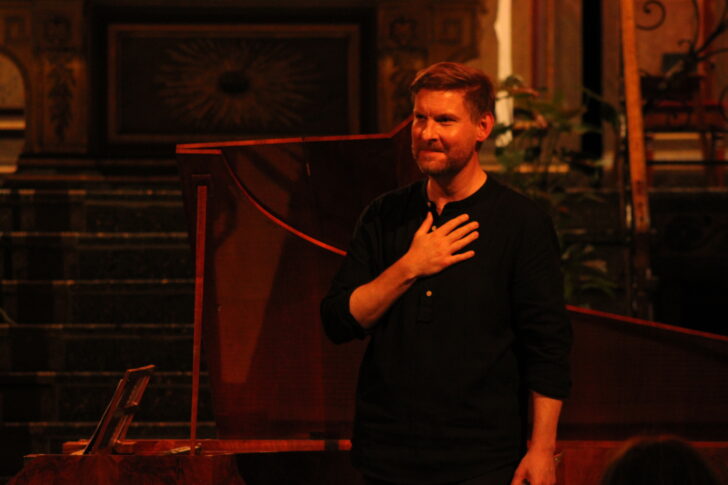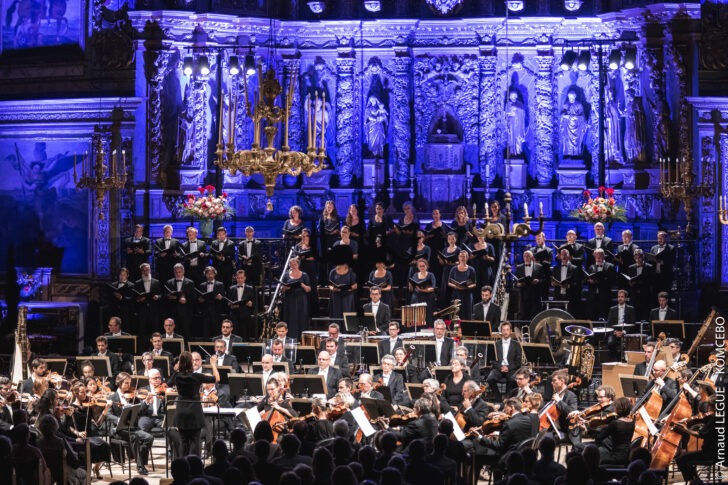More details
Ravel Festival in the Basque Country. 1-3-IX-2022.
Cambo-les-Bains, Church. 01-IX-2022. Wolfgang-Amadeus Mozart (1756-1791): Sonatas and Rondo for piano. Kristian Bezuidenhout, pianoforte.
Saint-Jean-de-Luz, Church of Saint-Jean-Baptiste. 02-IX-2022. Ralph Vaughan-Williams (1872-1958): Fantasy on a theme by Thomas Tallis; Maurice Ravel (1875-1937): Scheherazade; Maurice Duruflé (1902-1986): Requiem op.9. Patricia Petibon, soprano. National Bordeaux Aquitaine Orchestra, Chorus of the National Opera of Bordeaux, direction Ariane Matiakh, Salvatore Caputo, conductor.
Hernani (Spain). Chillida-Leku Foundation. 03-IX-2022. Olivier Messiaen (1908-1992): Twenty Looks at the Child Jesus. Bertrand Chamayou, piano.
The Basque Country vibrates at the end of summer to the sound of music by Ravel, but also composers from all eras from the 17th century to the present day. Report of three days of peregrination from Mozart to Messiaen at the Ravel Festival.
With its squat and protective silhouette, the Rhune dominates the town of Saint-Jean-de-Luz and its neighbour, Ciboure, located on either side of the mouth of the Nivelle. It was there, in Ciboure, that Maurice Ravel was born in 1875. Attached to these roots and certainly also to the sweetness of life in this pretty town on the Basque coast, he often stayed in Saint-Jean-de-Luz, surrounded by his friends: Marguerite Long, Jacques Thibaud, Gustave Samazeuilh, Ricardo Viñes, Fedor Chaliapin… That is to say if the music permeated the place! It has never stopped since: in the 1960s, a festival (Musique en côte basque) was created there, then an academy (Académie Ravel). Finally, the two merge in 2020 to become the Festival Ravel, with the duo at its artistic direction, Jean-François Heisser and Bertrand Chamayou, formerly master and student.
This new festival offers a wide musical panorama turned towards modernity, a program where around the works of Ravel gravitate as well those of Élisabeth Jacquet de la Guerre, Mozart, as those of Xenakis, Messiaen, Stockhausen and Pärt. With his Academy, which now also includes a composition class, this year under the direction of Philippe Manoury and Ramon Lazkano, he is looking to the future. It also becomes cross-border, partner of the musical institutions of Euskadi, in particular the Musikene School of San Sebastián, investing high cultural places of the Spanish Basque country.
Mozart in Period Sounds by Kristian Bezuidenhout
It is in the church of the spa town of Cambo-les-Bains that Kristian Bezuidenhout comes to give a Mozart recital on a pianoforte by Paul McNulty, a copy from a Viennese pianoforte by Anton Walter (Walter et fils 1805), similar to the one the composer owned. The pianist chose four of his works composed after his return to Vienna in 1784. From the first played, the Sonata No. 17 in B flat major K.570, he arouses admiration, so refined, elegant and captivating is his playing. Here is a musician who knows how to use freedom, invention, by a fine ornamentation with which he adorns in particular the covers in a more or less abundant way, while structuring the musical discourse with rigor and clarity. It is all the delicate art of suggestion that appears in his way of phrasing, of finding expressive movement without ever forcing it. A support, a light rubato are enough, at the beginning of the first movement for example, to make expressive and beautiful the sinuosities of the phrase, whose first note from which everything flows is always thought out before being played, posed as often in the final. In the Sonata No. 15 in F major K.533/494, his vigorous playing highlights the colors of the chords, their bold harmonies, and the counterpoint, in a perfect balance of registers. The Andante of Rondo No. 3 in A minor K.511 with its gently melancholy tone is movingly modest. The tumultuous meanders follow, the eruptions of the Sonata No. 14 in C minor K.457 whose interpreter underlines the dramaturgy, grasping the keyboard with firmness, making the bass ring out in an amplitude that one does not expect on such an instrument, giving an almost Beethovenian foundation to its tormented pages. His pianoforte sounds and breathes, sings and confides tirelessly, in the length of the sound, in a range of sound colors that the subtle use of the pedal operated by knee lever and the mute sublimate. It is on this same instrument that Kristian Bezuidenhout, who recorded the complete keyboard works of Mozart, will give the next day, during his master class, a masterful music lesson to two young pianists, radically transforming their playing. .

Around Ravel, Vaughan-Williams and Duruflé in Saint-Jean-de-Luz
The next day a large format concert is given in the Saint-Jean-Baptiste church of Saint-Jean-de-Luz, the very one where the wedding of Louis XIV was celebrated, epicenter of the festival. Under the rich Baroque altarpiece, the strings of the Orchester National Bordeaux Aquitaine have taken their place. In the program for the evening, three works come together in an unexpected way. Ralph Vaughan-Williams and Maurice Ravel worked together on modern instrumentation and orchestration for three months between 1907 and 1908, three months which were enough to seal a lasting friendship between them. The music of the British composer, who was not ultimately influenced by Ravel, is of extraordinary strength. Evidenced by this Fantasy on a Theme by Thomas Tallis, led by chef Ariane Matiakh. Written for string orchestra and string quartet (heads of desks), it is inspired by a theme from the English Renaissance that the composer often took as a reference. A captivating and intense work, of a powerful lyricism, played by the orchestra and its remarkable soloists in a perfect homogeneity of the desks. Ariane Matiakh manages to support the continuous, frantic and deep singing during the eighteen minutes of its performance, in constant emotional tension. Scheherazade de Ravel then lightens the atmosphere with the scent of her oriental dreams and her disturbing beauty. The orchestra is then complete to accompany the voice of Patricia Petibon with its shimmering timbres. In spite of a direction very attentive to the supple and nuanced inflections of the song, this one is at times covered, under the orchestral luxuriance favored by the acoustics of the place. Patricia Petibon, however, gives the three sung poems the beautiful colors of her voice, the clarity of her diction and all that is needed of sensuality, lasciviousness, and finally the overall impression remains a delight, just like the superb melody of the flute heard in the magic flute (2). The second part of the concert reveals an astonishing affinity between the Requiem by Maurice Duruflé and the work of Vaughan-Williams heard at the beginning of the concert. The chorus of the Opéra National de Bordeaux, beautifully prepared by its conductor Salvatore Caputo, joined the orchestra, behind the slightly raised winds. Monumental work irrigated with Gregorian chant and fruit of the fervent inspiration of its composer, the Requiem alternates power and contemplation in its nine well-differentiated parts. Ariane Matiakh emphasizes the contrasts, emphasizing its dramatic dimension, but also the meditative one, the precise gesture, ensuring the balance between choir and music stands, leading the orchestra into extreme nuances: from the feeling of peace (introit) and comforting softness (sublime Pie Jesus and his moving cello solo) with sepulchral sonorities which open the Dominate Jesu Christein the impressive crescendos of the sanctus and Free mein the serene light of Lux aeterna and the movement of life that animates the air Agnus Deiin In Paradisum whose peaceful atmosphere reminds us of that of the Faurean pages. Finally, let us salute the intensity and beauty of the timbres of the choir, whose diction of the liturgical text is perfectly understandable.
Miraculous Twenty Looks by Bertrand Chamayou
Heading for Spain the next day, to Twenty Looks at the Child Jesus by Olivier Messiaen by Bertrand Chamayou in Hernani, in the Zabalaga farm, in the middle of the immense marked out sculpture park of the Chillida-Leku Foundation. The place is not chosen at random. Eduardo Chilliga, a Basque visual artist who died in 2002, who had a passion for Bach, has continued to multiply the connections between his art, the sound universe and music as a “path to spirituality”. It is therefore among his works, many of which carry a mystical message, that the pianist takes us on a new “odyssey”, after having, a few days earlier, given in a row the complete Years of Pilgrimage of Franz Liszt, in another place of the festival. We will salute this new performance, just as much as the immeasurable beauty of this giant fresco that he paints in front of us with the keyboard, this “cathedral”, this musical Sistine Chapel that are the Vingt Regards, of which he has just published the recording ( Erato). The proximity of the piano and the musician only increases this feeling of being caught in the heart of this music, so dense, so gushing, so profuse, so disproportionate, to experience its brilliance, to experience its striking immediacy. , to be overwhelmed by his unspeakable poetry. It takes endurance to play these two hours of music without interruption, to give body and soul to this demanding music. Bertrand Chamayou gives a specific density to each of “his” Regards that should all be reviewed. Let’s just mention the infinite sweetness of the Gaze of the Virgin (such as that of Fra Angelico’s virgins), the staggering energy deployed and the titanic force of By him everything was donethe explosion of colors of the Gaze of the Spirit of Joy everything in abundance, the so delicate and mysterious First Communion of the Virgin and its virtuoso bird vocalizations subtly haloed by the pedal, the sumptuous ringtones of the Gaze of Angels almost dancing in the treble sky, the luminous and miraculous Kiss of the Child Jesus sung and prodigious of sweetness at the beginning, the terrifying empty chords and the lightning flashes of the Gaze of Terrible Anointingthe lunar and contemplative I sleep but my heart watchesand finally the size of the Gaze of the Church of Love. Of this cycle which he discovered at the age of 9, Bertrand Chamayou told us after this concert that he had not pierced all the mysteries, that the work somewhere still escaped him, at least exceeded him… We do not We can only believe the opposite, after hearing it like that that day.
Another Messiaen monument awaited the festival-goer the next day, in Bayonne, the one we had heard this summer at the Berlioz Festival by the same interpreters: From the Canyons to the Starsgiven as a co-production, the recording of which has just been released by Mirare.
Photo credits: ©Komcebo/Festival Ravel, ©Pierre-Alexandre Carré-PAC (Kristian Bezuidenhout), and ©JC/ResMusica (Bertrand Chamayou)
(Visited 70 times, 10 visits today)
More details
Ravel Festival in the Basque Country. 1-3-IX-2022.
Cambo-les-Bains, Church. 01-IX-2022. Wolfgang-Amadeus Mozart (1756-1791): Sonatas and Rondo for piano. Kristian Bezuidenhout, pianoforte.
Saint-Jean-de-Luz, Church of Saint-Jean-Baptiste. 02-IX-2022. Ralph Vaughan-Williams (1872-1958): Fantasy on a theme by Thomas Tallis; Maurice Ravel (1875-1937): Scheherazade; Maurice Duruflé (1902-1986): Requiem op.9. Patricia Petibon, soprano. National Bordeaux Aquitaine Orchestra, Chorus of the National Opera of Bordeaux, direction Ariane Matiakh, Salvatore Caputo, conductor.
Hernani (Spain). Chillida-Leku Foundation. 03-IX-2022. Olivier Messiaen (1908-1992): Twenty Looks at the Child Jesus. Bertrand Chamayou, piano.
Tags for this article
We would love to thank the author of this write-up for this outstanding web content
Trip to the Basque Country from Mozart to Messiaen at the Ravel Festival – ResMusica
Take a look at our social media profiles as well as other pages related to themhttps://nimblespirit.com/related-pages/

